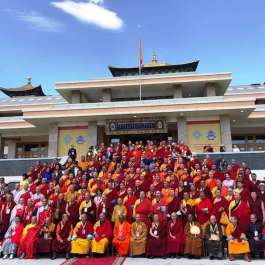
As ordinary human beings, we live with duality, multiplicity, and paradox. In the US, people of white, European descent comprise the dominant culture, and this dominance is based on a history of the suppression and genocide of Indigenous peoples. But although genocidal tactics and attempted cultural erasure continue today—through the government and individuals—Native Americans are far from gone. There are 6.4 million in the US, representing 574 tribes, and many more belonging to non-federally recognized groups. Yet I find in conversations with North American and European Buddhists that there is sometimes unawareness, ignorance, and even disinterest in the original peoples of North America.
In mainstream culture, discrimination, continued cultural appropriation, and violence toward Native Americans persist, especially women and children. It is imperative to reverse these trends, which can only occur through the empowerment of Indigenous people and taking an honest assessment of the US history of oppression. Expressive arts are one form of agency and voice for Indigenous artists. Art has power!
Allying with Indigenous Americans in support of their well-being—as they see it—is a key point of activism and compassion-in-action. On this continent, we live with the duality of who we are now, who our white ancestors were, and the complex impact that this has on Indigenous cultures. Indigenous peoples, both individually and collectively, have been severely impacted by the European colonizing of North America. One way, of many, to address this fact is to educate ourselves and to support the arts as meaningful expressions of historically oppressed people.

Since living in Boulder, Colorado, I have had the great fortune to encounter the art of Gregg Deal, a prolific multimedia artist working with, in his own words, “honoring Indigenous experiences, challenging stereotypes, and pushing for accurate representations of Indigenous people in art.” Deal, of the Pyramid Lake Paiute Nation in Utah, uses several languages to preserve and express. Deal expresses himself as a contemporary artist through the “voice” of paint, sculpture, film, photography, found object art, and his literal voice (storytelling, narrative, TEDx talks):
Deal’s work is informed by his Native identity and includes exhaustive critiques of American society, politics, popular culture, and history. Through paintings, murals, performance work, filmmaking, spoken word, and more, Deal invites the viewer to confront these issues both in the present and the past tense.
(Gregg Deal)
The last phrase is most apt, present and past tense. I find his work to bring up a swirl of thoughts and emotions that leave me asking more questions—of myself and of our culture—and make me want more: more immersion, more education, and more exposure to Native voices through the arts. Deal’s work also leaves me asking about the future and what it holds for healing, further expression, and that healing means different things to each of us.
Deal curated a recent group show at the Longmont Museum titled Duality, bringing together diverse voices of Indigenous artists working in many styles and media, traditional and modern. This exhibition showcases resilience, disruption, tension, truth, beauty, paradox. As an educator, I really appreciated the connected exhibition of student artwork from the Denver area in which Indigenous children express themselves: their pain, confusion, celebration, anger, resilience, sorrow, and defiance of erasure and discrimination.
For two years, I worked for a small non-profit that supported the efforts at Standing Rock to resist the Dakota Access Pipeline (DAPL) running through the Standing Rock Sioux Nation. The DAPL still threatens to interfere with tribal sovereignty, their health, and land and water rights. That experience was an eye-opener for me. It is a privilege to support these efforts, which continue, not only in the Dakotas, but in so many places in the US, where various pipelines and oil and gas projects denigrate and destroy Native people and lands.
Partially because I lived in New Mexico as an artist and educator, and was exposed to a multitude of Native artforms, I find it impossible to ignore the vitality of Native American art. Music, visual arts, performance art, sculpture, mixed media, spoken word, writing, or the hard-to-categorize arts are not only the expressions of Native people but a mode of cultural survival and non-erasure. Art is its own kind of language, and language is essential to cultural—and personal—preservation. Native languages are key to survival and thriving as well, and for this reason many tribal Nations work to preserve their languages, in schools and in digital tool formats—dictionaries, stories, databases, school curricula, collecting/documenting oral histories. Much of the work in Duality joined traditional methods and modern styles and materials in exciting, moving, and innovative ways.

I had the pleasure of watching one of Gregg’s mural creations in process in Boulder, Colorado, and viewed his work in Santa Fe, Denver, and Longmont, Colorado. His films and performance art, viewable online, are incredibly impactful. He works with elements spanning pop culture to comics, film, photography, punk rock, sculpture, painting, mixed media, and print-making to reappropriate negative imagery from our collective ongoing colonial-settler culture that relies on the denigration of Indigenous people. Deal’s live work conveys at times fear, rage, and grief, along with joy, humor, and complexity, which I imagine is all rather exhausting for an artist to embody. The material is vulnerable and very genuine. Deal’s art makes a real impact and enriches our world.
As a white Westerner, doing the work of facing the racism, bias, and violence in the US is necessary spiritual work. The more I learn and un-learn, the more there is to learn/unlearn. Although art is symbolic/metaphoric/dream-like, it is also a more direct language to the heart and mind than conversation. The misrepresentation and erasure of Native America in our school curricula is sadly familiar. I grew up with the mythical “Pilgrims and friendly Indians” narrative in Massachusetts. Becoming a teacher meant studying and redeveloping curricula for students that was more inclusive and honest—work that continues to this day. With conservative, ignorant backlash, we now see inclusive, accurate curricula itself a battleground of (mis)information in courts of law and school boards. This too greatly affects the well-being of Indigenous students.

Gregg Deal’s art goes straight to the heart of the matter with pathos and humor. Much of his art conveys the brutality of what it is to live under the constant threat of denigration, aggressive behaviors, and violence, yet still compels the viewer to experience more. The work is intense, yet one is drawn in, one marker of great art. In his TEDx talks, films, and other video projects, Deal keenly challenges the viewer to stay in contact with him. He has a way through his own presence, voice, and expression to engender empathy even alongside tough topics. There are many layers to his film The Last American Indian, which documents others’ reactions to his walking around Washington, D.C., in stereotypical “Indian” garb. Reactions range from awkward to discomfiting to downright absurd, heartbreaking, and deeply disturbing. The average American simply does not know what to do when encountering a “real” (or a “fake”) Indian, but seems to think they know what qualifies, and find ways to dominate, erase, degrade, or deny.
Deal offers viewers the same dignity anyone would want, and lets the works speak for themselves. Even his bold cartoon-based paintings both are and are not driving home a point like a hammer to a nail head. Deal’s work is detailed and well-crafted, with bold color and beautiful design, layered with meaning and messages. Even with his static art, there’s a conversation that develops, showing the complexity and maturity of his art. Deal’s art looks backward, at the present, and forward, leaving as many questions to chew on as “a-ha” moments to experience, and leaves one wondering, how will these questions evolve, resolve, change, or stagnate?
In my view, awareness + empathy = compassionate action. Without action, we are part of the problem. Yet to get to the action stage, we need to understand a problem, empathize with those harmed, and even the harmers, while preventing more harm. Especially if we have a part in the harm-doing. Looking at ourselves is the hardest, most necessary work.

We hear a lot about Truth and Reconciliation commissions, but there must be listening and recognition before reconciliation or healing can begin. This is also engaged Buddhism: to engage with the world as it is, and walk toward suffering with an open heart, if we mean to uphold our vow that the path is for the liberation of all sentient beings, and not just those privileged or dominant. Liberation starts with the willingness to listen, to feel discomfort, to keep listening, to dialogue, and to pay respect and attention, to do the hard work of examining ourselves, past and present. Then to act for the welfare and well-being of people in distress, or who are owed reparations. Let this, then, be our meditation-in-action, the focal point of a spiritual life.
See more
Gregg Deal
Duality: Contemporary Works by Indigenous Artists (City of Longmont Colorado)
The Last American Indian on Earth (Vimeo)
Teaching and Learning about Native Americans (National Museum of the American Indian)
Related features from BDG
Still Standing: Resistance and Resilience of the Standing Rock Sioux Nation
Restoration and Justice: An Interview with Dr. Natalie Avalos on Indigenous Spirituality and Buddhist Allies
Buddhistdoor View: Indigenous Relations – Restoration and Restitution
Related news reports from BDG
Buddhist Center Joins Tribal Advocates and Local Residents to Oppose Asphalt and Gravel Pit Development in Montana
The University of Notre Dame Wraps Up “Faith in the Story” Workshops Aiming to Enhance Religious Literacy
Buddhists in Massachusetts Initiate Peace Walk to Honor Native Americans Buddhist Nun Embarks on Thanksgiving Prayer Walk in New York State















